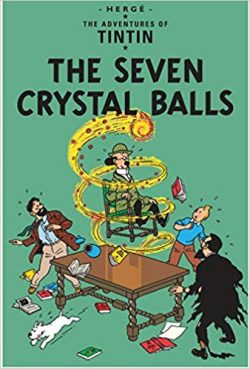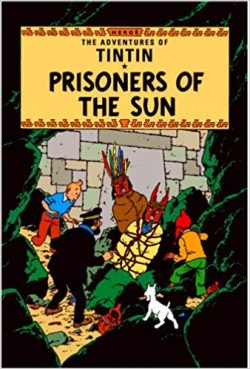

By Hergé & various; translated by Leslie Lonsdale-Cooper & Michael Turner (Egmont)
ISBNs: 978-0-82885-071-1 (HB Crystal Balls)
978-1-40520-624-2 (PB Crystal Balls)
978-1-40520-813-0 (HB Sun)
978-1-40520-625-9 (PB Sun)
Georges Prosper Remi Рknown universally as Herg̩ Рcreated a true masterpiece of graphic literature with his astounding yarns tales of a plucky boy reporter and his entourage of iconic associates.
Singly, and later with assistants including Edgar P. Jacobs, Bob de Moor and the Hergé Studio, Remi completed 23 splendid volumes (originally produced in brief instalments for a variety of periodicals) that have grown beyond their popular culture roots and attained the status of High Art.
It’s only fair, though, to ascribe a substantial proportion of credit to the many translators whose diligent contributions have enabled the series to be understood and beloved in 38 languages. The subtle, canny, witty and slyly funny English versions are the work of Leslie Lonsdale-Cooper & Michael Turner.
On leaving school in 1925, Remi worked for Catholic newspaper Le Vingti̩me Si̩cle where he fell under the influence of its Svengali-like editor Abbot Norbert Wallez. The following year, the young artist Рa passionate and dedicated boy scout, produced his first series: The Adventures of Totor for monthly Boy Scouts of Belgium magazine.
By 1928, Remi was in charge of producing the contents of the parent paper’s children’s weekly supplement Le Petit Vingtiéme while discontentedly illustrating The Adventures of Flup, Nénesse, Poussette and Cochonette when Abbot Wallez urged the artist to create an adventure series. Perhaps a young reporter who would travel the world, doing good whilst displaying solid Catholic values and virtues?
And also, perhaps thereby highlighting and exposing some the Faith’s greatest enemies and threats…?
Having recently discovered the word balloon in imported newspaper strips, Remi decided to incorporate this simple yet effective innovation into his own work. He would produce a strip both modernistic and action-packed.
Beginning in early January 1929, Tintin in the Land of the Soviets appeared in weekly instalments, running until May 8th 1930. Accompanied by his garrulous dog Milou (Snowy to us Anglophones), the clean-cut, no-nonsense boy-hero – a combination of Ideal Good Scout and Remi’s own brother Paul (a soldier in Belgium’s army) – would report back all the inequities of the world, since the strip’s prime conceit was that Tintin was an actual foreign correspondent for Le Petit Vingtiéme…
The odyssey was a huge success, assuring further – less politically-charged and controversial – exploits to follow. At least that was the plan…
During the Nazi Occupation of Belgium, Le Petit Vingtiéme was closed down. Hergé was compelled to move his popular strip to daily newspaper Le Soir (Brussels’ most prominent French-language periodical, appropriated and controlled by the Nazis). He diligently toiled on for the duration, but following Belgium’s liberation was accused of collaboration and even being a Nazi sympathiser.
It took the intervention of Belgian Resistance war-hero Raymond Leblanc to dispel the cloud over Herg̩, which he did by simply vouching for the cartoonist and by providing the cash to create a new magazine РLe Journal de Tintin Рwhich Leblanc published and managed. The anthology comic swiftly achieved a weekly circulation in the hundreds of thousands.
Begun in conquered Belgium and running in daily instalments, Les Sept Boules de Cristal began in December 1943 but was abruptly shelved when the Allies arrived in September 1944. Hergé, tarred as a collaborator, was unable to work for two years. When he was cleared the story resumed, serialised in Le Journal de Tintin from September 26th 1946 to April 22nd 1948
In 1943 the artist had met Edgar P. Jacobs, who became his assistant. They began with this extended adventure-tale which is now divided into eerie thriller The Seven Crystal Balls and grandiose epic Prisoners of the Sun. These dates seem odd but once again the Nazi conquest holds the answers.
For Belgium. Liberation day was September 3rd 1944. When the occupiers fled, workers on Le Soir were arrested as potential collaborators or Nazi sympathizers and the newspaper was closed down. For the two years they were under suspicion, Hergé, Jacobs and Alice Devos spent their time adapting old Tintin adventures for release as colour albums. The Seven Crystal Balls remained unfinished and unpublished until Raymond Leblanc stepped in.
Anthological Le Journal de Tintin continued the tale before completing the saga with Le Temple du Soleil. During this period, Jacobs left Hergé when the artist supposedly refused him a by-line for his work. At that time, Jacobs was also producing his own science-adventure masterpiece Blake and Mortimer which also featured in the weekly Tintin.
The Seven Crystal Balls sees affable old soak Captain Haddock returned to family manse Marlinspike Hall where he is adjusting (poorly) to his new-found wealth, and the prospect of exasperating Professor Cuthbert Calculus as his house-guest.
When Tintin and Snowy visit, a trip to the theatre embroils them all in a baffling enigma wherein the survivors of the South American Sanders-Hardiman Expedition all successively fall into comas due to an Incan curse and some rather suspect strangers. Tintin soon determines someone more solid than ethereal is causing the tragedies, but even he can’t stop the attacks, and soon he and his friends are also on the mysterious malefactor’s “to-do†list…
When Calculus is abducted from under their very noses, Haddock gives up his life of luxury and resumes adventuring once more, determined to help Tintin rescue their friend and solve the mystery.
Giving chase. they narrowly miss the villains at a seaport but still have a chance to beat the ship carrying Calculus if they board a sea-plane for Peru…
This is classic hairsbreadth storytelling. The pace is spellbinding and the ever-present slapstick actually serves to heighten the tension of the chase. The tale ends on a cliff-hanger, which is only right and proper. Still, imagine how you’d have felt all those decades ago when the conclusion was months away…
The helter-skelter drama continues in as, in the Port of Callao, Tintin and Haddock anxiously await the arrival of the freighter Pachacamac. However, when it arrives, suspected of carrying their kidnapped friend Cuthbert Calculus, the vessel flies a plague-pennant. There is Yellow Fever aboard and nobody can approach her!
And so begins Prisoners of the Sun, epic conclusion of the maddening mystery of Inca curses and the doomed Sanders-Hardiman Expedition to South America…
Suspecting a trick, Tintin sneaks aboard and finds the Professor, only to be driven away by gunfire. After telephoning Haddock, he chases the abductors, leaving the Captain and inept detectives Thompson and Thomson to catch up if they can. The chase takes them deep into the beautiful, rugged country where they finally reunite, only to become the target of many murder attempts, and other methods of dissuasion.
Undaunted, Tintin and Haddock continue their trek towards the mountains, and are befriended by Zorrino, a young lad who risks his own life to help them cross valleys, mountain-ranges and jungles, dodging death from both beasts and men, until they are all finally captured by the last remnants of a lost, wondrous and deeply cautious civilisation…
This is an epic staggering in scope and breathtaking in execution. Whether drawing a battle, choreographing a pratfall or delineating a golden temple, the clean precise line of the art and the simplified colour palette makes every panel “realer-than realâ€, whilst the captivating imagination of the storytelling makes this a truly graphic narrative.
These are two of the best comic adventures of all time and they demand a place on every fan’s bookshelves.
The Seven Crystal Balls: artwork © 1948, 1975 Editions Casterman, Paris & Tournai.
Text © 1962 Egmont UK Limited. All Rights Reserved.
Prisoners of the Sun: artwork © 1949, 1977 Editions Casterman, Paris & Tournai.
Text © 1962 Egmont UK Limited. All Rights Reserved.
